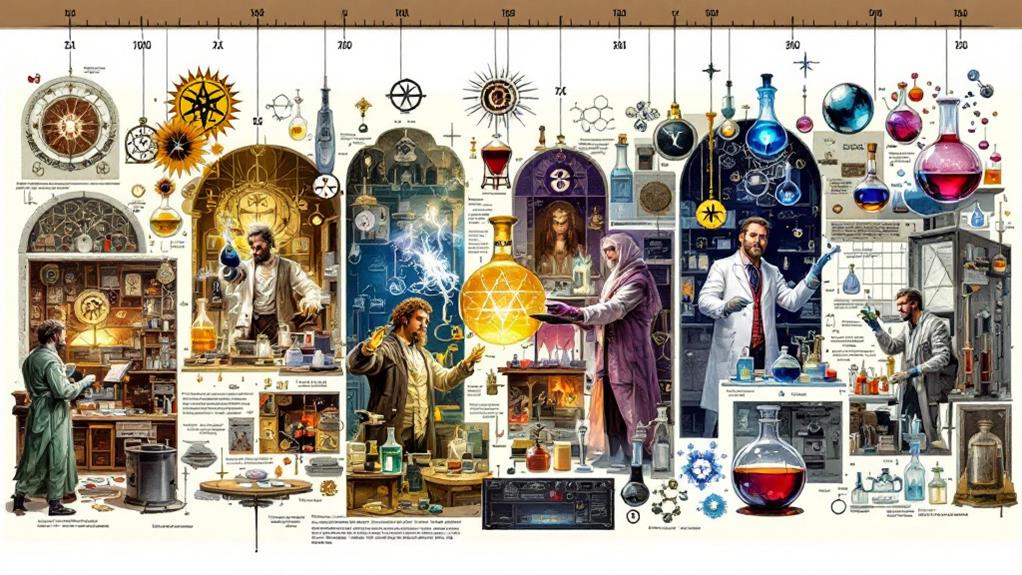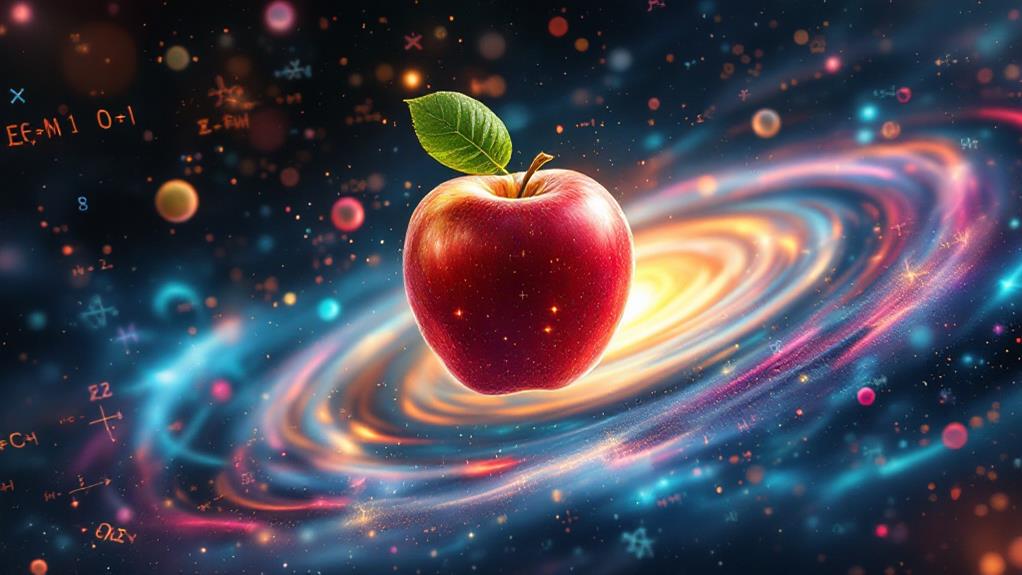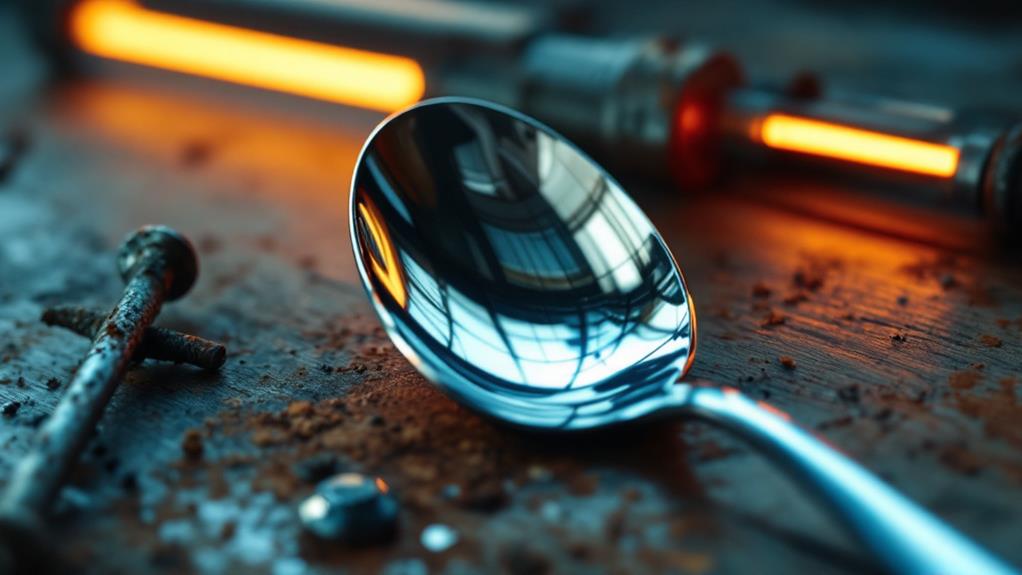Crazy Chemistry Facts: Surprising Discoveries From the Lab
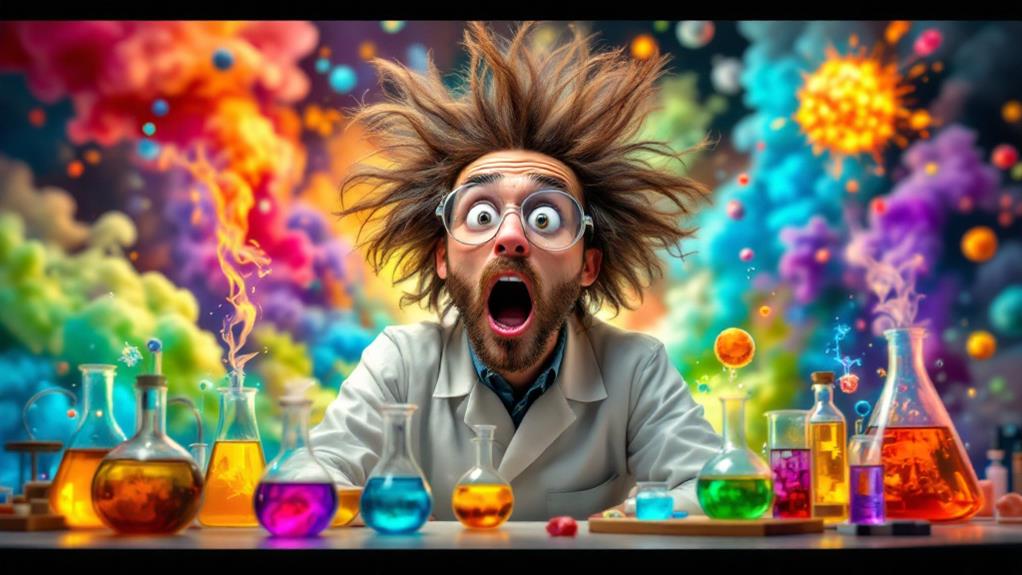
You'll be amazed by the wild world of chemistry! Did you know some elements explode on contact with water, while certain liquids can defy gravity? Imagine metals that melt in your hand or invisible ink that reveals secrets. Chemistry even gives us fire without heat and materials that can heal themselves. Glow-in-the-dark reactions light up the lab, challenging our understanding of the physical world. These mind-bending revelations showcase the unexpected wonders hiding in everyday matter. From shape-shifting substances to edible experiments, chemistry's surprises are just waiting to be unearthed. Prepare to have your perception of reality turned upside down!
Elements That Explode in Water
While most elements interact harmlessly with water, a select few react explosively upon contact. You'll find these volatile substances among the alkali metals, particularly the heavier ones like potassium, rubidium, and cesium. When exposed to water, these reactive alkali metals rapidly form hydroxides and release hydrogen gas, generating enough heat to ignite the hydrogen and create a dramatic explosion.
Sodium, though less reactive, still produces a vigorous reaction. You've probably seen videos of sodium chunks skittering across water's surface, leaving behind a trail of fizz and small flames. But the real show-stoppers are francium and cesium. These elements react so violently with water that they can detonate on contact with atmospheric moisture alone.
It's not just pure metals that pose a risk. Certain explosive metal compounds, like sodium peroxide or potassium superoxide, can also react dangerously with water. These substances are used in specialized applications but require careful handling to prevent accidental contact with moisture. Remember, while these reactions may seem exciting, they're extremely dangerous and should only be performed by trained professionals in controlled laboratory settings.
Liquids Defying Gravity
Shifting from explosive water reactions, let's investigate some mind-bending liquid behavior. You might think all liquids obey gravity, but some defy this fundamental force in surprising ways. Buoyant liquids, for instance, can float on denser fluids, creating stunning visual effects.
Counterintuitive fluid dynamics come into play when you observe the Leidenfrost effect. If you drop water onto an extremely hot surface, it'll actually hover above it on a cushion of its own vapor. This phenomenon can even allow you to dip your hand briefly into molten lead without injury.
Another gravity-defying liquid trick is the "liquid bridge" experiment. By applying an electric field, you can stretch a liquid between two containers, forming a bridge that seems to float in mid-air. Even more bizarre is superfluid helium, which can flow upwards, against gravity, and escape its container by creeping up the sides.
These examples of liquids defying gravity showcase the fascinating world of chemistry, where the rules you think you know can be bent or broken entirely.
Metals That Melt in Hand
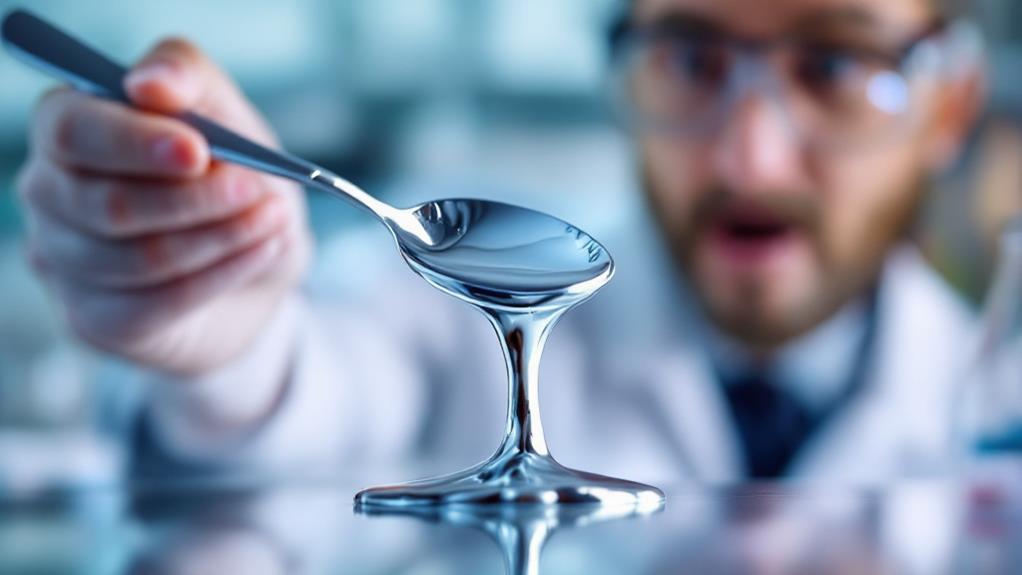
Three metals possess the extraordinary ability to melt in your hand. These instant metal transformations defy our common understanding of the thermodynamic properties of metals. Gallium, cesium, and francium are the remarkable elements that can liquefy at or near body temperature.
Gallium, with a melting point of 85.6°F (29.8°C), is the most accessible of these metals. You'll find it solid at room temperature, but it'll quickly turn into a silvery puddle in your palm. Cesium melts at an even lower 83.3°F (28.5°C), while francium liquefies at a slightly higher 80.6°F (27°C).
These metals' unique properties make them compelling subjects for scientific study and practical applications:
- Gallium is used in semiconductors and high-temperature thermometers
- Cesium is essential in atomic clocks and GPS technology
- Francium's extreme rarity limits its practical use but offers valuable insights into atomic structure
- Low-melting metals can create liquid seals in certain industrial processes
- They're crucial in developing new types of cooling systems
Understanding these metals' behavior helps scientists explore novel materials with tailored melting points, potentially transforming various industries and technological applications.
Invisible Ink Secrets
From melting metals to hidden messages, chemistry offers a world of fascinating phenomena. When it comes to invisible ink secrets, you'll find an array of secret writing techniques that have been used throughout history. One simple method involves using lemon juice or milk as ink. When you write with these liquids on paper, the message remains invisible until heat is applied, revealing the hidden text.
Another intriguing technique employs phenolphthalein, an acid-base indicator. You can write your message using a basic solution, and it will remain invisible until exposed to ammonia vapors, causing the text to appear pink. For a more modern approach, you can create UV-reactive invisible ink using laundry detergent or tonic water, which contains quinine. These messages are only visible under ultraviolet light.
Some invisible inks rely on chemical reactions to reveal hidden messages. For example, writing with iron sulfate solution remains invisible until exposed to potassium ferrocyanide, which turns the text blue. These secret writing techniques demonstrate the power of chemistry in concealing and revealing information, making invisible ink an engaging subject for both spies and science enthusiasts alike.
Fire Without Heat
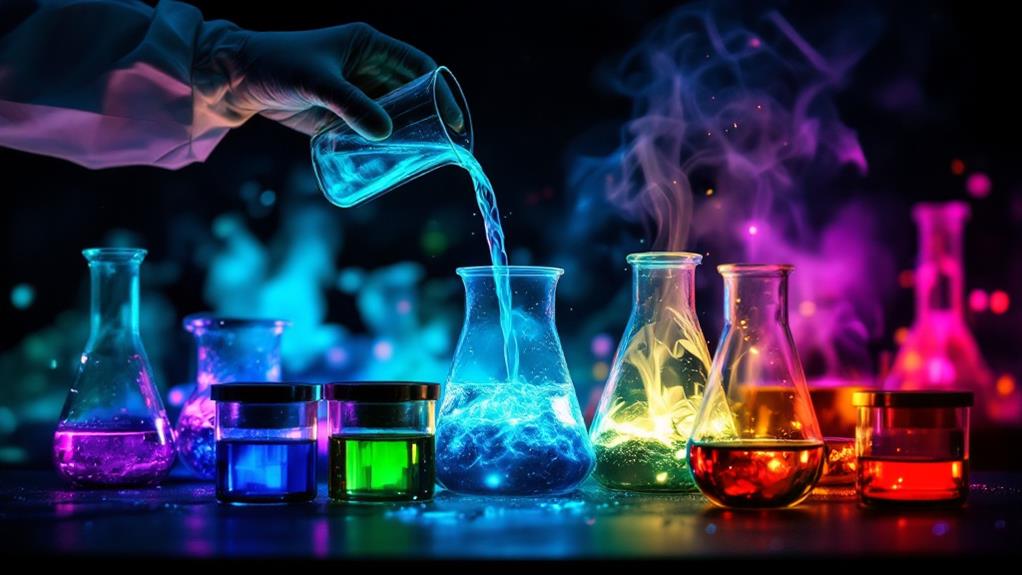
While most people associate fire with intense heat, you can actually create flames without high temperatures. This phenomenon, known as cold combustion or flameless oxidation, challenges our conventional understanding of fire. It occurs when certain chemicals react with oxygen in the air, producing light and sometimes even visible flames, but without the intense heat we typically expect.
You'll find cold combustion in various applications, from emergency lighting to forensic investigations. One common example is the eerie glow of a light stick, which results from a chemical reaction that produces light without significant heat. Another instance is the blue glow you might observe when cutting certain cheeses - a result of oxidation caused by the knife's interaction with fats and oils.
- Challenges traditional perceptions of fire
- Demonstrates the complexity of chemical reactions
- Highlights the importance of oxygen in combustion processes
- Illustrates the diverse nature of light-producing reactions
- Showcases practical applications of unusual chemical phenomena
Cold combustion isn't just a scientific curiosity; it has real-world uses. Researchers are exploring its potential in developing more efficient engines and improving our understanding of cellular processes. As you probe deeper into chemistry, you'll uncover that fire without heat is just one of many fascinating chemical oddities that defy our expectations.
Self-Healing Materials
Envision a world where your scratched phone screen or cracked car windshield could repair itself. This isn't science fiction; it's the reality of self-healing materials. Scientists have developed self repairing polymer structures that can mend damage without human intervention.
These autonomously healing composites work through various mechanisms. Some contain microcapsules filled with healing agents that rupture when damaged, releasing the repair substance. Others use reversible chemical bonds that can reform after being broken. You'll find these materials in applications ranging from electronics to aerospace.
Imagine your smartphone's screen closing up small scratches on its own, or your car's paint job fixing minor dings while parked. Self-healing concrete could revolutionize infrastructure maintenance, while self-repairing fabrics could extend the life of your favorite clothes.
The potential of these materials goes beyond convenience. They could substantially reduce waste, improve product longevity, and enhance safety in critical applications. As research progresses, you'll likely see more self-healing materials in your everyday life, quietly repairing themselves and changing how we think about product durability and maintenance.
Glow-in-the-Dark Chemical Reactions
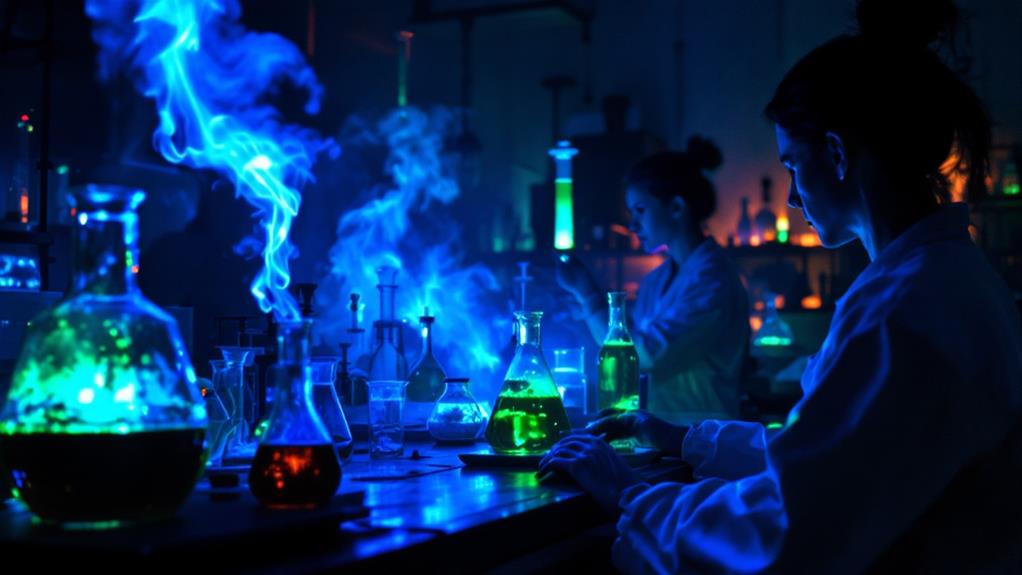
Glow-stick enthusiasts and science lovers alike are fascinated by chemiluminescence, the eerie light produced by certain chemical reactions. You've probably seen this phenomenon in action at concerts or Halloween parties, but did you know it's a result of complex chemical processes? Chemiluminescent reactions occur when excited electrons release energy in the form of light, creating a mesmerizing glow without generating heat.
Fluorescent compounds play a pivotal role in these reactions, absorbing and emitting light at different wavelengths. Scientists have leveraged this knowledge to develop a wide range of applications, from forensic analysis to deep-sea exploration. You can even create your own glow-in-the-dark experiments at home using household items!
They're highly efficient, converting chemical energy directly into light. The color of the glow depends on the specific compounds used. Some living organisms, like fireflies, use bioluminescence for communication. Chemiluminescence can detect trace amounts of blood at crime scenes. Certain chemical reactions can produce light that lasts for hours or even days.
Understanding these fascinating reactions opens up a world of possibilities for future innovations in lighting, medicine, and environmental monitoring.
Shape-Shifting Substances
From the alluring glow of chemical reactions, we turn our attention to another mind-bending aspect of chemistry: shape-shifting substances. You might think of shape-shifting as something out of science fiction, but it's a real phenomenon in the world of chemistry.
One fascinating example is polymorphic crystal structures. These are solid materials that can exist in multiple forms, each with distinct physical properties. You've probably encountered this without realizing it. Chocolate, for instance, can crystallize into six different forms, each with a unique melting point and texture.
Another intriguing category is stimulus-responsive hydrogels. These smart materials can change their shape or size in response to external stimuli like temperature, pH, or light. Imagine a substance that expands when exposed to heat or contracts in acidic environments. These shape-shifters have potential applications in drug delivery, tissue engineering, and even soft robotics.
The ability of substances to change form isn't just a chemical curiosity; it's opening up new possibilities in materials science and technology. As you investigate deeper into chemistry, you'll uncover that the world of shape-shifting substances is full of surprises and potential.
Edible Chemistry Experiments
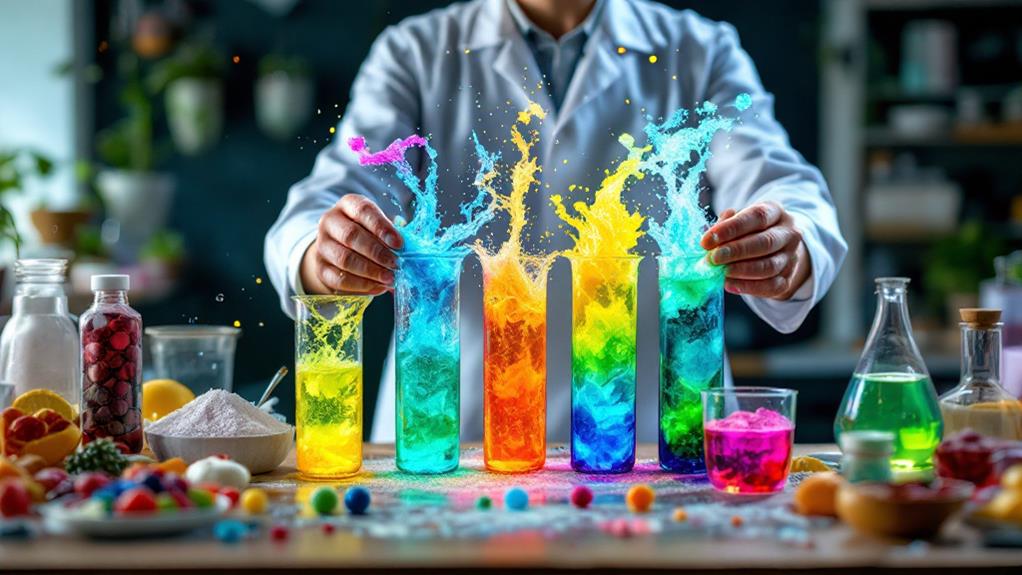
After investigating shape-shifting substances, let's plunge into the delicious world of edible chemistry experiments. You'll be amazed at how everyday kitchen ingredients can transform into fascinating scientific demonstrations. From creating your own natural food coloring using red cabbage to whipping up homemade vitamin gummies, these experiments are both educational and tasty.
You can witness chemical reactions in action as you mix baking soda and vinegar to create an erupting lava cake, or observe the effects of osmosis by making gummy bear "grow" in water. These edible experiments not only teach important scientific concepts but also encourage curiosity and creativity in the kitchen.
Enhances understanding of chemical reactions
Promotes hands-on learning
Develops cooking skills
Encourages scientific thinking
Provides a fun and engaging way to explore science
